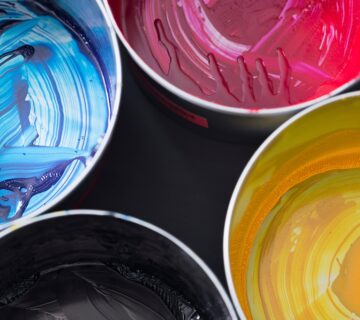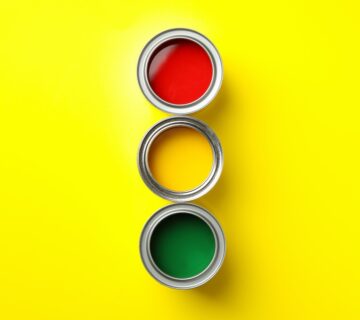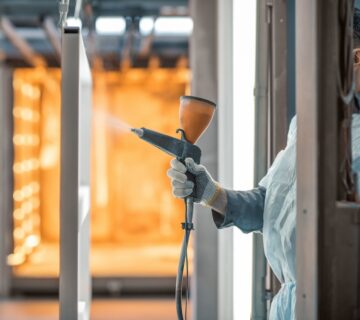The type of paint you choose and the climate in which you live both significantly influence the lifespan of a paint job. Various climates challenge paint in different ways, from the intense sunlight and heat to cold, moisture, and salt air. Knowing how different types of paint perform in various climates enables you to select the best option for your home’s exterior and interior, ensuring both durability and longevity. In this blog, we explore the resilience of various paint types across different climate conditions, providing insights to help you make informed decisions and protect your investment in your home’s appearance and structural integrity.
Paint Types and Their Characteristics
Acrylic Paints
Acrylic paints have gained recognition for their exceptional durability and remarkable resistance to fading. Their popularity for exterior applications stems from their robust nature, capable of enduring even the harshest weather conditions. Particularly in regions characterized by abundant sunlight and intense heat, acrylic paints stand out for their ability to retain their vibrant colors and resist cracking. This resilience not only ensures the longevity of your home’s exterior surfaces but also contributes to maintaining their visual allure, safeguarding your property with enduring protection and enduring aesthetic charm.
Oil-Based Paints
Oil-based paints are valued for their richness and smooth finish. They perform well in areas with fluctuating temperatures, providing a durable layer that resists cracking. However, they can take longer to dry and are prone to fading under intense sunlight. Despite these drawbacks, their ability to withstand temperature variations makes them suitable for regions with unpredictable weather patterns, ensuring a lasting finish on your home’s interior and exterior surfaces.
Latex Paints
Latex paints are water-based and offer good durability and easy clean-up. They are less susceptible to environmental damage, making them a good choice for a variety of climates. In humid conditions, their breathability helps prevent mold and mildew growth, maintaining a healthy and attractive environment within your home. With their versatility and resilience, latex paints provide a reliable option for both interior and exterior painting projects, regardless of the climate challenges they may face.
Impact of Climate on Paint
Hot and Dry Climates
In hot and arid climates, paint faces relentless exposure to intense UV rays and high temperatures, posing a threat of fading and degradation. However, acrylic and latex paints fortified with UV protection emerge as the optimal choice for such demanding conditions. These specialized formulations not only withstand the scorching heat and harsh sunlight but also exhibit exceptional resistance to cracking and fading. By preserving their pristine appearance over time, these paints effectively safeguard the visual integrity of your home’s exterior surfaces, ensuring that its beauty endures despite the unforgiving environmental challenges.
Cold and Wet Climates
Cold and damp climates present a formidable obstacle with moisture accumulation, which can provoke peeling and foster mold growth on painted surfaces. In such environments, latex paints offer a distinct advantage owing to their inherent flexibility and impressive resistance to moisture. While oil-based paints can also demonstrate resilience in these conditions, they often demand more frequent maintenance to endure the relentless exposure to moisture and fluctuating temperatures. By opting for latex paints, homeowners can ensure that their surfaces remain protected against the detrimental effects of moisture, maintaining a durable and visually appealing finish that withstands the rigors of cold and wet climates.
Coastal Climates
Coastal climates present a unique set of challenges characterized by salt-laden air and elevated humidity levels, which can accelerate paint corrosion, diminishing its lifespan and compromising its protective capabilities. However, acrylic and latex paints fortified with anti-corrosive properties emerge as ideal solutions for these environments. By effectively resisting the corrosive effects of salt air and high humidity, these specialized paints ensure long-term durability and aesthetic appeal for your home’s exterior surfaces. With their robust protection against corrosion and moisture, acrylic and latex paints provide homeowners in coastal regions with peace of mind, knowing that their investment is safeguarded against the harsh coastal elements, preserving the beauty and integrity of their homes for years to come.
Variable Climates
In regions characterized by a diverse range of weather conditions, spanning from sweltering summers to frigid winters, paint must exhibit versatility to endure temperature extremes and fluctuations. Latex paints emerge as a top choice in such environments due to their inherent flexibility, which effectively prevents cracking and maintains structural integrity during temperature variations. Whether applied to interior or exterior surfaces, latex paints deliver a durable and long-lasting finish that withstands the rigors of changing weather patterns. By harnessing the flexibility of latex paints, homeowners can confidently protect their properties against the challenges of unpredictable weather, ensuring enduring beauty and resilience throughout the seasons.
Tips for Maximizing Paint Longevity
- Proper Preparation: Regardless of the climate, proper surface preparation is crucial for the longevity of a paint job. Thorough cleaning, priming, and repairing any surface imperfections ensure optimal adhesion and durability of the paint finish.
- Quality Matters: Investing in high-quality paint with additives suitable for your climate can save costs in the long run. Quality paints are formulated to withstand specific environmental challenges, providing superior protection and longevity compared to lower-quality alternatives.
- Regular Maintenance: Regular inspections and touch-ups can extend the life of your paint, regardless of the type and climate. Monitoring for signs of wear, damage, or fading allows for timely maintenance, preserving the integrity and appearance of your home’s paint job over time.
- Professional Application: Professional application ensures that the paint is applied correctly, which can significantly affect its longevity. Experienced painters have the knowledge, skills, and equipment to properly prepare surfaces, apply paint evenly, and address any issues that may arise during the painting process, resulting in a flawless finish that stands the test of time and weather.
Final Thoughts
The longevity of paint in various climates is influenced by the type of paint used and the specific environmental challenges. By choosing the right type of paint and taking appropriate measures for maintenance and application, you can ensure that your paint job stands the test of time and weather. With careful consideration of paint characteristics and climate factors, along with proactive maintenance and professional application, you can enjoy a beautiful and durable finish on your home’s interior and exterior surfaces for years to come. For more information on selecting the right paint for your climate, visit our website at sisupainting.com and explore our blog at sisupainting.com/blog.





No comment